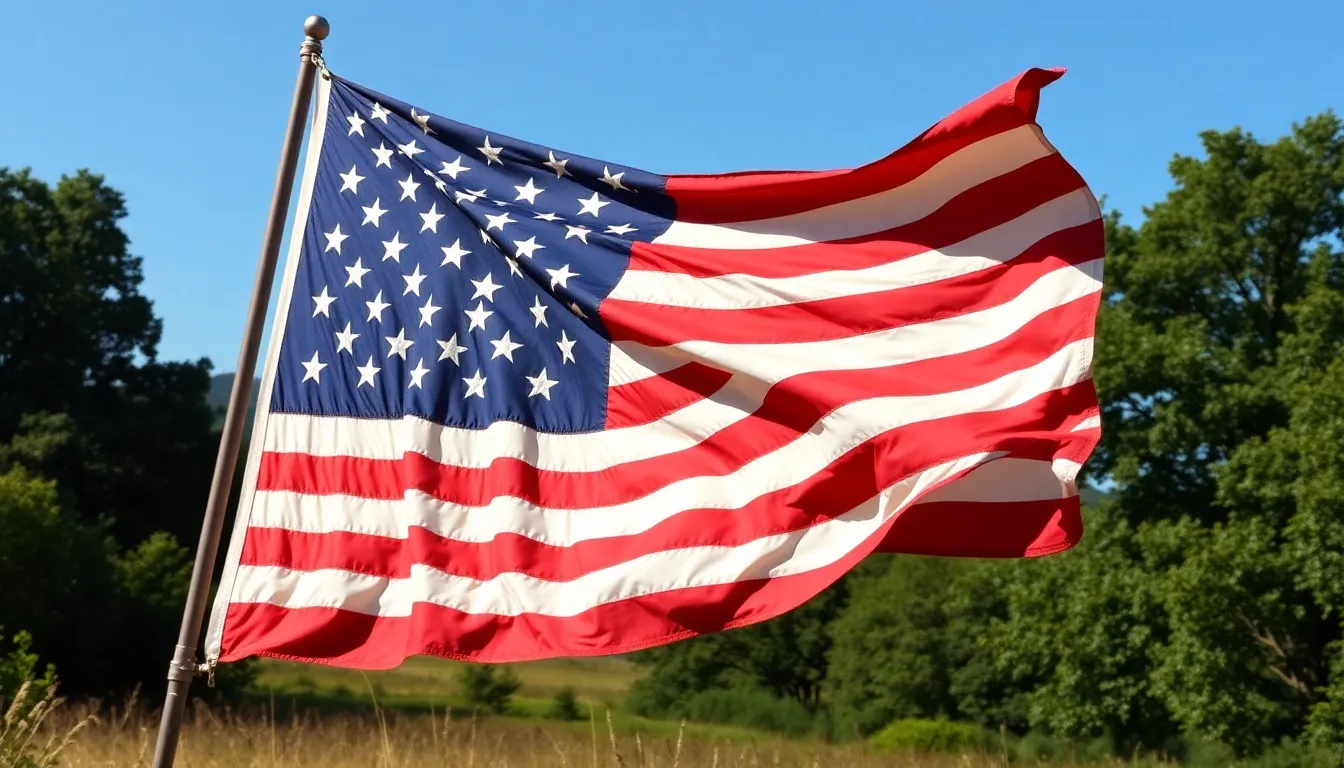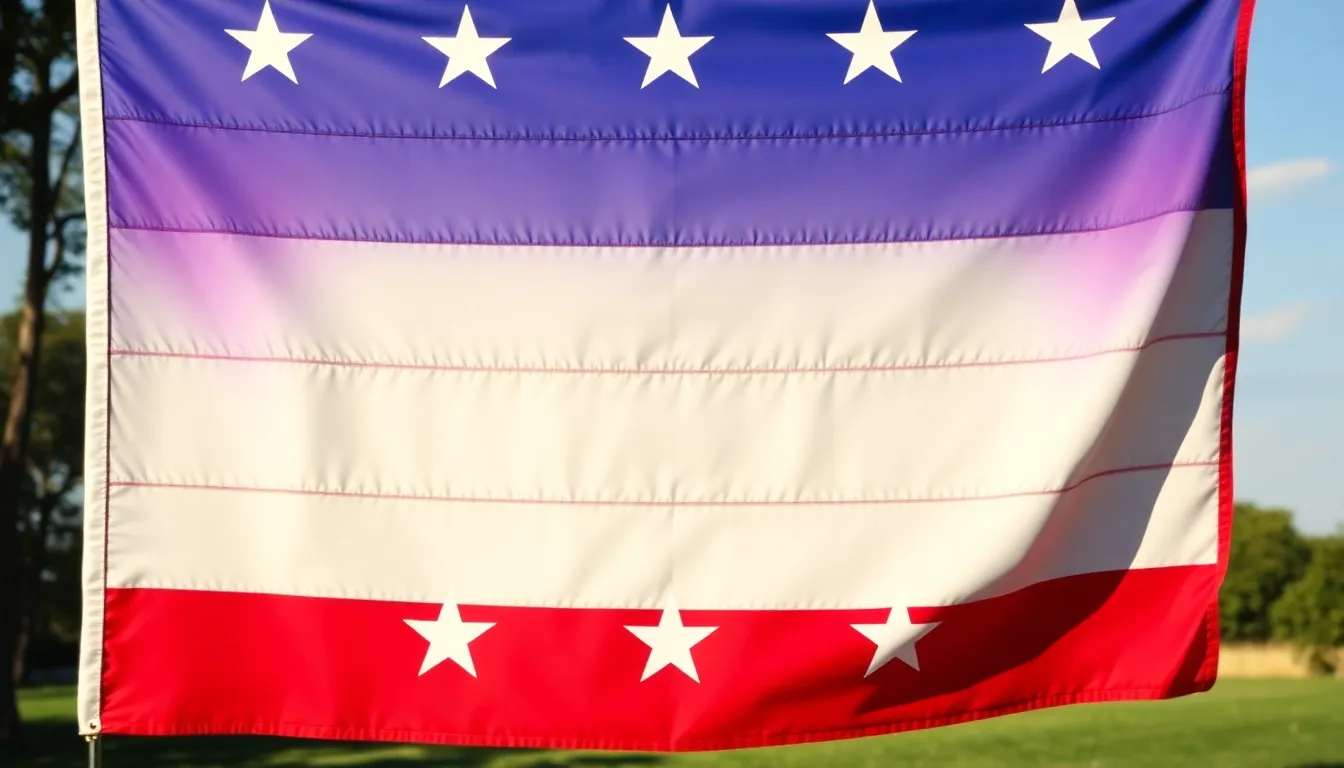When it comes to American history, few symbols evoke as much pride as the flag. But did you know there was a time when the Stars and Stripes flaunted just nine stars? That’s right! Before the nation expanded and added more states, this unique version of the flag captured a moment in time that’s both fascinating and a tad quirky.
Table of Contents
ToggleOverview of the US Flag with 9 Stars
The US flag with nine stars emerged during a transformative period in American history. This flag first appeared in 1798 when the nation consisted of just nine states. Stars represented each state, signifying an evolving national identity.
Each star held significant meaning, marking states that were integral to the early formation of the United States. The flag, often referred to as the “Star-Spangled Banner,” demonstrated early unity among the states through its unique design.
Nine stars showcased a blend of hope and ambition for future growth. As states joined the Union, the flag’s design adapted, reflecting these changes. Its symbolism lies not only in the stars but also in the colors. Red stands for valor, white symbolizes purity, and blue signifies justice.
Historical contexts reveal that this specific flag was short-lived, replaced as the nation grew. Internally, it sparked discussions about state representation and national unity. Collectors now view the nine-star flag as a rare artifact representing early nationalism.
The nine-star design also appears in various historical documents, showcasing its legacy. Museums and exhibitions celebrate this version, emphasizing its significance in preserving American heritage. Existing reproductions keep this flag’s spirit alive, offering insights into the nation’s formative years.
Understanding the flag’s evolution highlights the dynamic nature of American history. Through the nine stars, each one carries a story of connection and advancement that forms the foundation of today’s United States.
Historical Significance

The nine-star flag holds a unique place in American history, representing a pivotal time of growth and identity. Originating during a transformative era, this flag symbolizes early unity among the states.
Origins of the 9-Star Flag
The nine-star flag first appeared in 1798 when the United States consisted of just nine states: Delaware, Pennsylvania, New Jersey, Georgia, Connecticut, Massachusetts, Maryland, South Carolina, and New Hampshire. Each star on the flag represented a state, reflecting the nation’s evolving identity. Star arrangements typically varied, but the design prominently featured stars on both blue and white backgrounds. Such changes in flag design marked an important moment as the nation began to establish its representation.
Key Events During Its Use
The nine-star flag saw notable use during events like the Quasi-War with France from 1798 to 1800. During this period, the flag became a symbol of national pride and resistance. It adorned ships and military installations, serving to bolster morale among troops and citizens alike. State representation sparked debates about the evolving nature of the Union, highlighting the importance of collaboration among states. Collectors now recognize this flag as a rare artifact of early American nationalism, adding to its historical significance.
Design Features
The nine-star flag showcases distinct design elements that highlight its historical importance. Understanding these features offers insight into the flag’s role in American heritage.
Star Arrangement
Stars on the nine-star flag are arranged in a unique pattern. They form three rows of three stars, creating an organized, symmetrical appearance. This arrangement reflects a sense of unity among the original nine states, emphasizing their collective identity. Each star represents a state, symbolizing the early framework of the nation. The arrangement simplifies recognition while maintaining visual appeal. Such configurational designs became precursors for later flags, influencing their star placements.
Color and Symbolism
Colors in the nine-star flag serve significant purposes. Red, white, and blue dominate its palette, with blue representing vigilance, perseverance, and justice. Red conveys valor and bravery, while white symbolizes purity and innocence. These colors connect to broader American values and ideals. The flag’s combination of hues and stars embodies unity, liberty, and the emerging national spirit. Understanding this symbolism enriches appreciation for the flag’s history and context in American life.
Variations and Adaptations
The nine-star flag showcases several variations that reflect the evolving designs of early American flags.
Different Versions of the 9-Star Flag
Different versions of the nine-star flag emerged during its limited use. Various configurations featured stars arranged in different patterns, including circular and row formats. Some versions presented stars that varied in size and shape, highlighting regional influences. Notably, the use of different fabrics also contributed to unique appearances. Flag manufacturers often experimented with color saturation, creating a visual identity for the nine states represented.
Influence on Later Flags
Influence on later flags can be traced back to the nine-star design, inspiring subsequent iterations. The arrangements and color schemes established in the nine-star flag set precedents that continued through the evolution of the American flag. Observers recognized the significance of incorporating stars to signify states, leading to the familiar patterns seen in later designs. In particular, the addition of new stars for each state reflected a growing national consciousness, connecting the past with present representations. The nine-star flag’s legacy continues to resonate in contemporary flag designs.
Cultural Impact
The nine-star flag has influenced various aspects of American culture, symbolizing a unique period in the nation’s history.
Representation in Popular Culture
Numerous references to the nine-star flag appear in popular culture, often highlighting themes of patriotism and historical identity. Artists and filmmakers have depicted this flag in artwork and documentaries, showcasing its significance during the late 18th century. Literature may also reference this flag to evoke national pride or historical nostalgia. Museums display the nine-star flag alongside artifacts, connecting viewers to early American life. Educational programs incorporate this flag to teach about statehood and unity among the original states.
Use in Ceremonial Contexts
Ceremonial events often feature the nine-star flag as a representation of historical milestones. During Independence Day celebrations, some communities choose to showcase this flag, emphasizing its role in American history. Flag-raising events at historical sites also include the nine-star flag to honor its connection to early national identity. Groups may display the flag during heritage festivals, celebrating the diverse roots that shaped the United States. Schools incorporate the nine-star flag in lessons or gatherings to inspire discussions about the nation’s evolution and the importance of unity.
The nine-star flag stands as a testament to a pivotal moment in American history. Its unique design and symbolism reflect the early unity among the original states. Though its use was brief, the flag’s impact resonates through various aspects of American culture and identity.
Collectors and historians alike treasure this flag as a rare artifact that encapsulates the spirit of a nation in transition. Its legacy continues to inspire discussions about representation and collaboration among states. The nine-star flag not only enriches the narrative of American heritage but also serves as a reminder of the enduring values that define the nation today.








